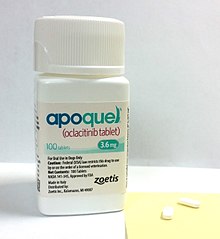 | |
 | |
| Clinical data | |
|---|---|
| Trade names | Apoquel |
| Other names | PF-03394197 |
| AHFS/Drugs.com | Veterinary Use |
| Routes of administration | By mouth |
| Drug class | JAK inhibitor |
| ATCvet code | |
| Legal status | |
| Legal status | |
| Pharmacokinetic data | |
| Bioavailability | 89%[1] |
| Protein binding | 66.3–69.7%[1] |
| Metabolism | Liver[1] |
| Elimination half-life | 3.1–5.2 hours[1] |
| Excretion | Mostly liver[1] |
| Identifiers | |
| |
| CAS Number | |
| PubChem CID | |
| ChemSpider | |
| UNII | |
| KEGG | |
| ChEMBL | |
| CompTox Dashboard (EPA) | |
| Chemical and physical data | |
| Formula | C15H23N5O2S |
| Molar mass | 337.44 g·mol−1 |
| 3D model (JSmol) | |
| |
| |
Oclacitinib, sold under the brand name Apoquel among others, is a veterinary medication used in the control of atopic dermatitis and pruritus from allergic dermatitis in dogs at least 12 months of age.[1][4] Chemically, it is a synthetic cyclohexylamino pyrrolopyrimidine janus kinase inhibitor that is relatively selective for JAK1.[5] It inhibits signal transduction when the JAK is activated and thus helps downregulate expression of inflammatory cytokines.[medical citation needed]
Oclacitinib was approved for use in the United States in 2013,[4] and in the European Union in 2023.[2][6]
- ^ a b c d e f g "Apoquel- oclacitinib maleate tablet, coated". DailyMed. 28 July 2021. Retrieved 19 February 2024.
- ^ a b "Prolevare EPAR". European Medicines Agency (EMA). 17 February 2023. Retrieved 19 February 2024.
- ^ "Apoquel EPAR". European Medicines Agency. 15 October 2013. Retrieved 26 June 2024.
- ^ a b "FDA Approves Apoquel (oclacitinib tablet) to Control Itch and Inflammation in Allergic Dogs" (Press release). Zoetis. 16 May 2013. Archived from the original on 23 February 2017. Retrieved 23 February 2017.
- ^ Gonzales AJ, Bowman JW, Fici GJ, Zhang M, Mann DW, Mitton-Fry M (August 2014). "Oclacitinib (Apoquel) is a novel Janus kinase inhibitor with activity against cytokines involved in allergy". Journal of Veterinary Pharmacology and Therapeutics. 37 (4): 317–324. doi:10.1111/jvp.12101. PMC 4265276. PMID 24495176.
- ^ "Prolevare Film-coated tablet". European Medicines Agency (EMA). 23 April 2023. Retrieved 19 February 2024.